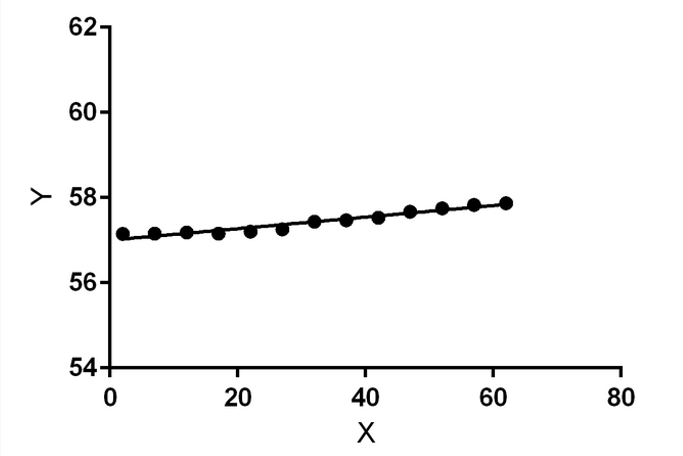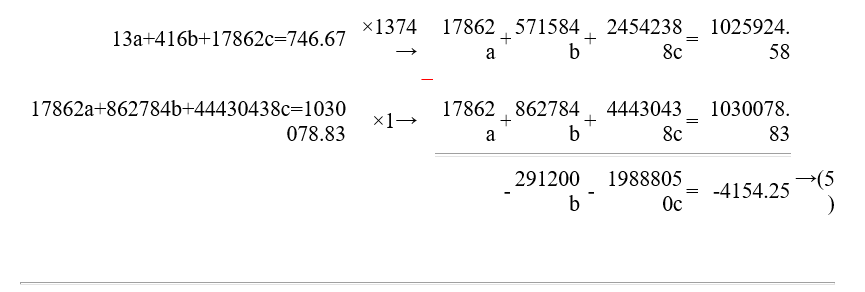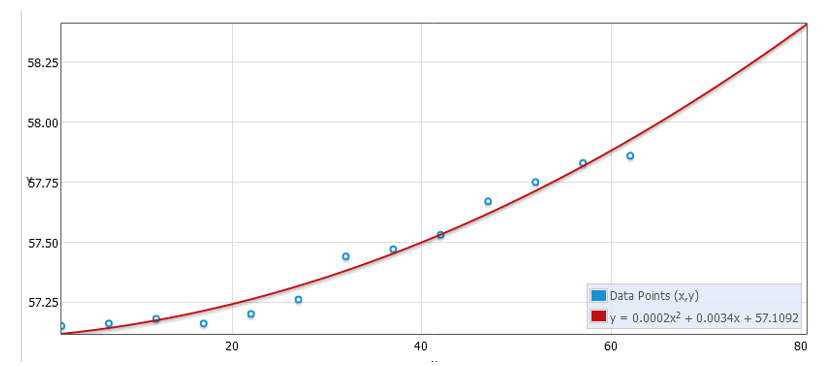
Concept explainers
(a)
To find: The linear regression model and scatter graph.
The model of the given data
Given information
The table for the given data is below.
| period | 2 | 7 | 12 | 17 | 22 | 27 | 32 | 37 | 42 | 47 | 52 | 57 | 62 |
| temperature | 57.15 | 57.16 | 57.18 | 57.16 | 57.20 | 57.26 | 57.44 | 57.47 | 57.53 | 57.67 | 57.75 | 57.83 | 57.87 |
For 1952,x=2
Straight line equation is y=a+bx.
The normal equations are
∑y=an+b∑x
∑xy=a∑x+b∑x2
The values are calculated using the following table
| x | y | x2 | x·y |
| 2 | 57.15 | 4 | 114.3 |
| 7 | 57.16 | 49 | 400.12 |
| 12 | 57.18 | 144 | 686.16 |
| 17 | 57.16 | 289 | 971.72 |
| 22 | 57.2 | 484 | 1258.4 |
| 27 | 57.26 | 729 | 1546.02 |
| 32 | 57.44 | 1024 | 1838.08 |
| 37 | 57.47 | 1369 | 2126.39 |
| 42 | 57.53 | 1764 | 2416.26 |
| 47 | 57.67 | 2209 | 2710.49 |
| 52 | 57.75 | 2704 | 3003 |
| 57 | 57.83 | 3249 | 3296.31 |
| 62 | 57.87 | 3844 | 3587.94 |
| --- | --- | --- | --- |
| ∑x=416 | ∑y=746.67 | ∑x2=17862 | ∑x·y=23955.19 |
Substituting these values in the normal equations
13a+416b=746.67
416a+17862b=23955.19
Solving these two equations using Elimination method,
13a+416b=746.67
and 416a+17862b=23955.19
13a+416b=746.67 →(1)
416a+17862b=23955.19 →(2)
equation(1)×32⇒416a+13312b=23893.44
equation(2)×1⇒416a+17862b=23955.19
Substracting ⇒-4550b=-61.75
⇒4550b=61.75
⇒b=61.754550
⇒b=0.0136
Putting b=0.0136 in equation (1), we have
13a+416(0.0136)=746.67
⇒13a=746.67-5.6457
⇒13a=741.0243
⇒a=741.024313
⇒a=57.0019
∴a=57.0019 and b=0.0136
Now substituting this values in the equation is y=a+bx, we get
The scatter graph of above data is below.

(b)
To find: The quadratic regression model and scatter graph.
The model of the given data
Given information
The table for the given data is below.
| period | 2 | 7 | 12 | 17 | 22 | 27 | 32 | 37 | 42 | 47 | 52 | 57 | 62 |
| temperature | 57.15 | 57.16 | 57.18 | 57.16 | 57.20 | 57.26 | 57.44 | 57.47 | 57.53 | 57.67 | 57.75 | 57.83 | 57.87 |
The equation is y=a+bx+cx2 and the normal equations are
The values are calculated using the following table
| x | y | x2 | x3 | x4 | x·y | x2·y |
| 2 | 57.15 | 4 | 8 | 16 | 114.3 | 228.6 |
| 7 | 57.16 | 49 | 343 | 2401 | 400.12 | 2800.84 |
| 12 | 57.18 | 144 | 1728 | 20736 | 686.16 | 8233.92 |
| 17 | 57.16 | 289 | 4913 | 83521 | 971.72 | 16519.24 |
| 22 | 57.2 | 484 | 10648 | 234256 | 1258.4 | 27684.8 |
| 27 | 57.26 | 729 | 19683 | 531441 | 1546.02 | 41742.54 |
| 32 | 57.44 | 1024 | 32768 | 1048576 | 1838.08 | 58818.56 |
| 37 | 57.47 | 1369 | 50653 | 1874161 | 2126.39 | 78676.43 |
| 42 | 57.53 | 1764 | 74088 | 3111696 | 2416.26 | 101482.92 |
| 47 | 57.67 | 2209 | 103823 | 4879681 | 2710.49 | 127393.03 |
| 52 | 57.75 | 2704 | 140608 | 7311616 | 3003 | 156156 |
| 57 | 57.83 | 3249 | 185193 | 10556001 | 3296.31 | 187889.67 |
| 62 | 57.87 | 3844 | 238328 | 14776336 | 3587.94 | 222452.28 |
| --- | --- | --- | --- | --- | --- | --- |
| ∑x=416 | ∑y=746.67 | ∑x·y=23955.19 |
Substituting these values in the normal equations
13a+416b+17862c=746.67
416a+17862b+862784c=23955.19
17862a+862784b+44430438c=1030078.83
Solving these 3 equations,
Total Equations are 3
13a+416b+17862c=746.67→(1)
416a+17862b+862784c=23955.19→(2)
17862a+862784b+44430438c=1030078.83→(3)
Select the equations (1) and (2), and eliminate the variable a.

Select the equations (1) and (3), and eliminate the variable a.

Select the equations (4) and (5), and eliminate the variable b.

Now use back substitution method
From (6)
1251250c=202.25
⇒c=202.251251250=0.0002
From (4)
-4550b-291200c=-61.75
⇒-4550b-291200(0.0002)=-61.75
⇒-4550b-47.0691=-61.75
⇒-4550b=-61.75+47.0691=-14.6809
⇒b=-14.6809-4550=0.0032
From (1)
13a+416b+17862c=746.67
⇒13a+416(0.0032)+17862(0.0002)=746.67
⇒13a+4.2294=746.67
⇒13a=746.67-4.2294=742.4406
⇒a=742.440613=57.1108
Solution using Elimination method.
a=57.1108,b=0.0032,c=0.0002
Now substituting this values in the equation is y=a+bx+cx2, we get
Scatter graph of the above data is given below

(c)
To find: Which model is best fit.
The quadratic model of the given data is best fit.
Given information
The quadratic model of the given data is best fit.
By observing the both graph it is seen that the data is more scatter to the quadratic graph and gives clear idea about how temperature goes up and down .Hence the quadratic model is best fit for the above data.
Chapter 2 Solutions
Precalculus: Graphical, Numerical, Algebraic Common Core 10th Edition
- 3.12 (B). A horizontal beam AB is 4 m long and of constant flexural rigidity. It is rigidly built-in at the left-hand end A and simply supported on a non-yielding support at the right-hand end B. The beam carries Uniformly distributed vertical loading of 18 kN/m over its whole length, together with a vertical downward load of 10KN at 2.5 m from the end A. Sketch the S.F. and B.M. diagrams for the beam, indicating all main values. Cl. Struct. E.] CS.F. 45,10,376 KN, B.M. 186, +36.15 kNm.7arrow_forwardQize f(x) = x + 2x2 - 2 x² + 4x²² - Solve the equation using Newton Raphsonarrow_forward-b±√√b2-4ac 2a @4x²-12x+9=0 27 de febrero de 2025 -b±√√b2-4ac 2a ⑥2x²-4x-1=0 a = 4 b=-12 c=9 a = 2 b = 9 c = \ x=-42±√(2-4 (4) (9) 2(4)) X = (12) ±√44)-(360) 2(108) x = ±√ X = =±√√²-4(2) (1) 2() X = ±√ + X = X = + X₁ = = X₁ = X₁ = + X₁ = = =arrow_forward
- 3.9 (A/B). A beam ABCDE, with A on the left, is 7 m long and is simply supported at Band E. The lengths of the various portions are AB 1-5m, BC = 1-5m, CD = 1 m and DE : 3 m. There is a uniformly distributed load of 15kN/m between B and a point 2m to the right of B and concentrated loads of 20 KN act at 4 and 0 with one of 50 KN at C. (a) Draw the S.F. diagrams and hence determine the position from A at which the S.F. is zero. (b) Determine the value of the B.M. at this point. (c) Sketch the B.M. diagram approximately to scale, quoting the principal values. [3.32 m, 69.8 KNm, 0, 30, 69.1, 68.1, 0 kNm.]arrow_forward4. Verify that V X (aẢ) = (Va) XẢ + aV X Ả where Ả = xyz(x + y + 2) A and a = 3xy + 4zx by carrying out the detailed differentiations.arrow_forward3. For each of the arrow or quiver graphs shown below, determine analytically V°C and V X Č. From these analytical solutions, identify the extrema (+/-) and plot these points on the arrow graph. (a) C = −✰CosxSiny + ŷSinxCosy -π<ׂу<π Ty (b) C = −xSin2y + ŷCos2y x, y<π -π< (c) C = −xCosx + ŷSiny -π< x, y < πarrow_forward
- 7.10 (B/C). A circular flat plate of diameter 305 mm and thickness 6.35 mm is clamped at the edges and subjected to a Uniform lateral pressure of 345 kN/m². Evaluate: (a) the central deflection, (b) the position and magnitude of the maximum radial stress. C6.1 x 10 m; 149.2 MN/m².] 100 200arrow_forward3.15 (B). A beam ABCD is simply supported at B and C with ABCD=2m; BC 4 m. It carries a point load of 60 KN at the free end A, a Uniformly distributed load of 60 KN/m between B and C and an anticlockwise moment of 80 KN m in the plane of the beam applied at the free end D. Sketch and dimension the S.F. and B.M. diagrams, and determine the position and magnitude of the maximum bending moment. CEL.E.] CS.F. 60, 170, 70KN, B.M. 120, +120.1, +80 kNm, 120.1 kNm at 2.83 m to right of 8.7arrow_forward7.1 (A/B). A Uniform I-section beam has flanges 150 mm wide by 8 mm thick and a web 180 mm wide and 8 mm thick. At a certain section there is a shearing force of 120 KN. Draw a diagram to illustrate the distribution of shear stress across the section as a result of bending. What is the maximum shear stress? [86.7 MN/m².arrow_forward
- 1. Let Ả = −2x + 3y+42, B = - - 7x +lý +22, and C = −1x + 2y + 42. Find (a) Ả X B (b) ẢX B°C c) →→ Ả B X C d) ẢB°C e) ẢX B XC.arrow_forward3.13 (B). A beam ABC, 6 m long, is simply-supported at the left-hand end A and at B I'm from the right-hand end C. The beam is of weight 100 N/metre run. (a) Determine the reactions at A and B. (b) Construct to scales of 20 mm = 1 m and 20 mm = 100 N, the shearing-force diagram for the beam, indicating thereon the principal values. (c) Determine the magnitude and position of the maximum bending moment. (You may, if you so wish, deduce the answers from the shearing force diagram without constructing a full or partial bending-moment diagram.) [C.G.] C240 N, 360 N, 288 Nm, 2.4 m from A.]arrow_forward5. Using parentheses make sense of the expression V · VXVV · Å where Ả = Ã(x, y, z). Is the result a vector or a scaler?arrow_forward
 Calculus: Early TranscendentalsCalculusISBN:9781285741550Author:James StewartPublisher:Cengage Learning
Calculus: Early TranscendentalsCalculusISBN:9781285741550Author:James StewartPublisher:Cengage Learning Thomas' Calculus (14th Edition)CalculusISBN:9780134438986Author:Joel R. Hass, Christopher E. Heil, Maurice D. WeirPublisher:PEARSON
Thomas' Calculus (14th Edition)CalculusISBN:9780134438986Author:Joel R. Hass, Christopher E. Heil, Maurice D. WeirPublisher:PEARSON Calculus: Early Transcendentals (3rd Edition)CalculusISBN:9780134763644Author:William L. Briggs, Lyle Cochran, Bernard Gillett, Eric SchulzPublisher:PEARSON
Calculus: Early Transcendentals (3rd Edition)CalculusISBN:9780134763644Author:William L. Briggs, Lyle Cochran, Bernard Gillett, Eric SchulzPublisher:PEARSON Calculus: Early TranscendentalsCalculusISBN:9781319050740Author:Jon Rogawski, Colin Adams, Robert FranzosaPublisher:W. H. Freeman
Calculus: Early TranscendentalsCalculusISBN:9781319050740Author:Jon Rogawski, Colin Adams, Robert FranzosaPublisher:W. H. Freeman
 Calculus: Early Transcendental FunctionsCalculusISBN:9781337552516Author:Ron Larson, Bruce H. EdwardsPublisher:Cengage Learning
Calculus: Early Transcendental FunctionsCalculusISBN:9781337552516Author:Ron Larson, Bruce H. EdwardsPublisher:Cengage Learning





